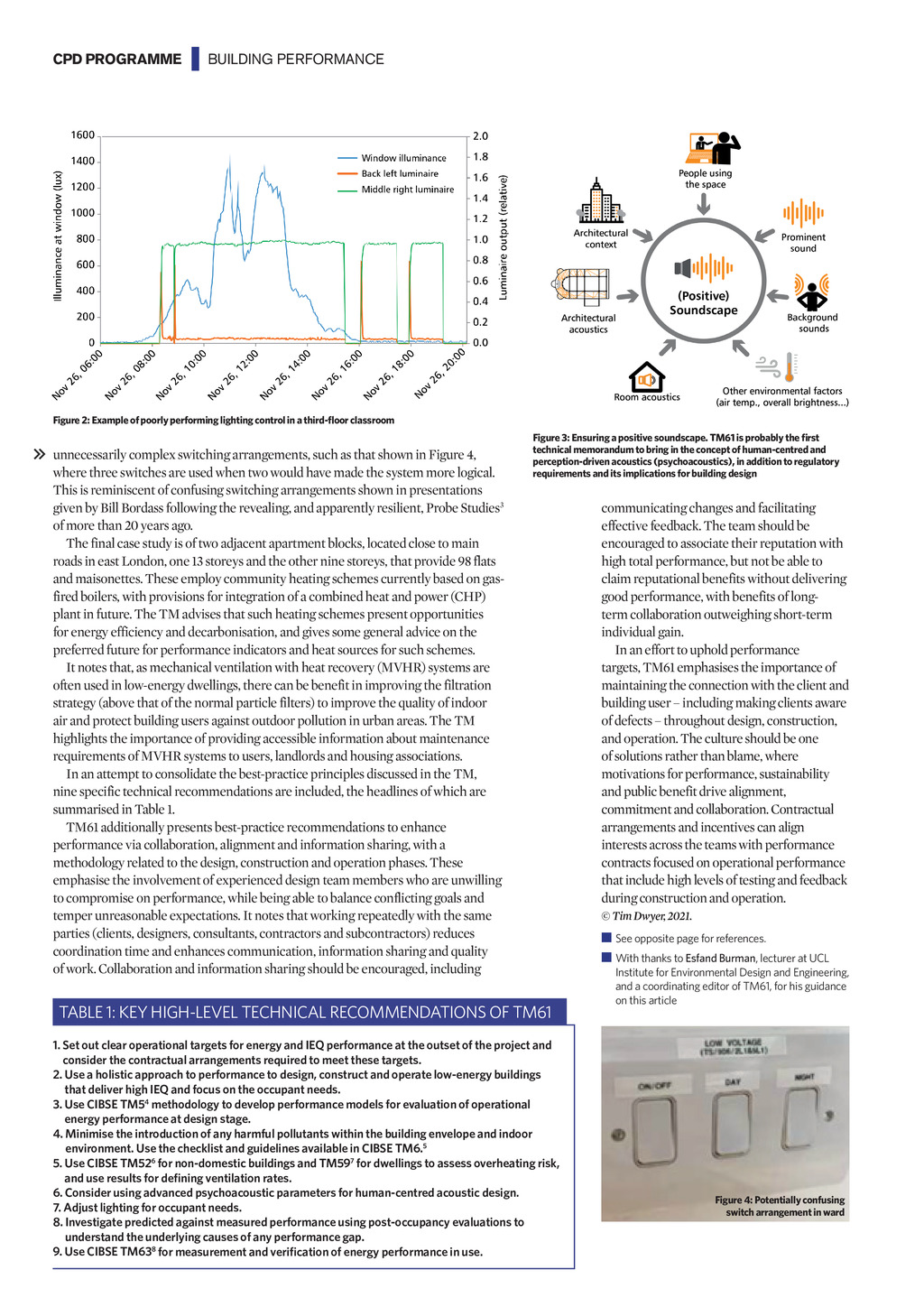




CPD PROGRAMME | BUILDING PERFORMANCE Figure 2: Example of poorly performing lighting control in a third-oor classroom unnecessarily complex switching arrangements, such as that shown in Figure 4, where three switches are used when two would have made the system more logical. This is reminiscent of confusing switching arrangements shown in presentations given by Bill Bordass following the revealing, and apparently resilient, Probe Studies3 of more than 20 years ago. The final case study is of two adjacent apartment blocks, located close to main roads in east London, one 13 storeys and the other nine storeys, that provide 98 flats and maisonettes. These employ community heating schemes currently based on gasfired boilers, with provisions for integration of a combined heat and power (CHP) plant in future. The TM advises that such heating schemes present opportunities for energy efficiency and decarbonisation, and gives some general advice on the preferred future for performance indicators and heat sources for such schemes. It notes that, as mechanical ventilation with heat recovery (MVHR) systems are often used in low-energy dwellings, there can be benefit in improving the filtration strategy (above that of the normal particle filters) to improve the quality of indoor air and protect building users against outdoor pollution in urban areas. The TM highlights the importance of providing accessible information about maintenance requirements of MVHR systems to users, landlords and housing associations. In an attempt to consolidate the best-practice principles discussed in the TM, nine specific technical recommendations are included, the headlines of which are summarised in Table 1. TM61 additionally presents best-practice recommendations to enhance performance via collaboration, alignment and information sharing, with a methodology related to the design, construction and operation phases. These emphasise the involvement of experienced design team members who are unwilling to compromise on performance, while being able to balance conflicting goals and temper unreasonable expectations. It notes that working repeatedly with the same parties (clients, designers, consultants, contractors and subcontractors) reduces coordination time and enhances communication, information sharing and quality of work. Collaboration and information sharing should be encouraged, including Figure 3: Ensuring a positive soundscape. TM61 is probably the rst technical memorandum to bring in the concept of human-centred and perception-driven acoustics (psychoacoustics), in addition to regulatory requirements and its implications for building design TABLE 1: KEY HIGH-LEVEL TECHNICAL RECOMMENDATIONS OF TM61 1. Set out clear operational targets for energy and IEQ performance at the outset of the project and consider the contractual arrangements required to meet these targets. 2. Use a holistic approach to performance to design, construct and operate low-energy buildings that deliver high IEQ and focus on the occupant needs. 3. Use CIBSE TM54 methodology to develop performance models for evaluation of operational energy performance at design stage. 4. Minimise the introduction of any harmful pollutants within the building envelope and indoor environment. Use the checklist and guidelines available in CIBSE TM6.5 5. Use CIBSE TM526 for non-domestic buildings and TM597 for dwellings to assess overheating risk, and use results for dening ventilation rates. 6. Consider using advanced psychoacoustic parameters for human-centred acoustic design. 7. Adjust lighting for occupant needs. 8. Investigate predicted against measured performance using post-occupancy evaluations to understand the underlying causes of any performance gap. 9. Use CIBSE TM638 for measurement and verication of energy performance in use. CIBSE Feb21 pp46-49 CPD 175 v2.indd 48 communicating changes and facilitating effective feedback. The team should be encouraged to associate their reputation with high total performance, but not be able to claim reputational benefits without delivering good performance, with benefits of longterm collaboration outweighing short-term individual gain. In an effort to uphold performance targets, TM61 emphasises the importance of maintaining the connection with the client and building user including making clients aware of defects throughout design, construction, and operation. The culture should be one of solutions rather than blame, where motivations for performance, sustainability and public benefit drive alignment, commitment and collaboration. Contractual arrangements and incentives can align interests across the teams with performance contracts focused on operational performance that include high levels of testing and feedback during construction and operation. Tim Dwyer, 2021. See opposite page for references. With thanks to Esfand Burman, lecturer at UCL Institute for Environmental Design and Engineering, and a coordinating editor of TM61, for his guidance on this article Figure 4: Potentially confusing switch arrangement in ward 22/01/2021 15:51